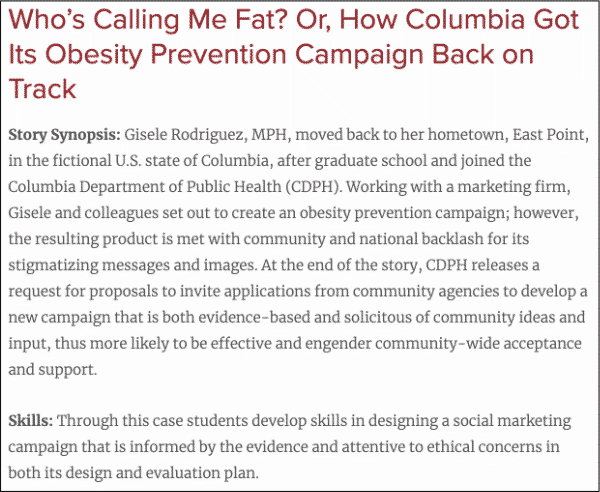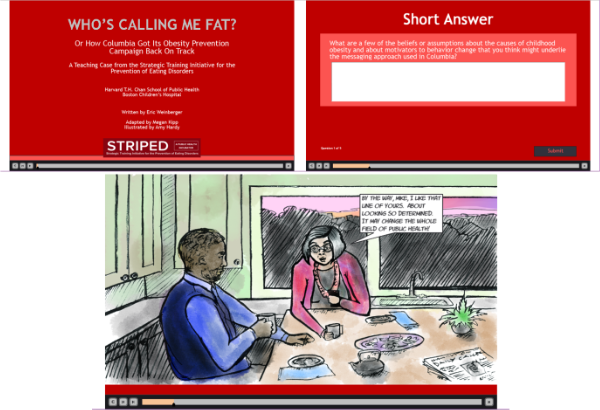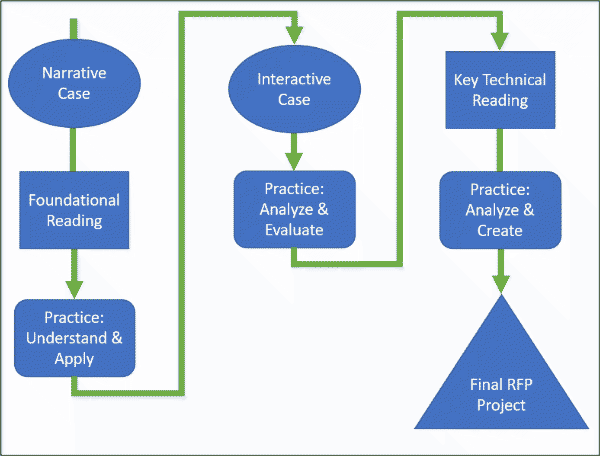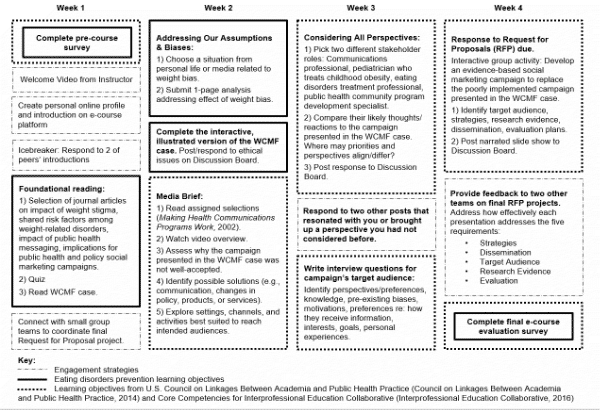Delivering Case Method Teaching Through Online Platforms
Adapting Active Learning Techniques and Maximizing Learner Engagement
Boston Children's Hospital, Bloom Learning Design & Harvard University
Abstract
With the goal of expanding case-method teaching via digital learning platforms in effective and engaging ways, we employed design strategies to transform an in-person course into an e-course. The curriculum of both versions of the course was intended to increase skills in developing a non-stigmatizing social marketing campaign for obesity prevention. We pilot-tested the e-course with 37 participants across the U.S. who completed pre- and post-course surveys with quantitative and qualitative components. The survey results indicated that participants’ knowledge significantly improved following the e-course. Participants gave high mean ratings on measures associated with level of engagement, satisfaction with the online format, and effectiveness of the course in increasing targeted skills. Qualitative feedback helped us evaluate strengths and areas for improvement in the course design. Key design strategies included a moderated discussion board; an illustrated, interactive version of the teaching case, which included prompts for reflection using technology available through the learning management system to enable small group work; and video conferencing to simulate face-to-face interaction. The findings of this e-course pilot study can inform future initiatives to deliver case-method teaching via online learning platforms.
Introduction
Case-method teaching is an inquiry-based instructional design that requires students to imagine themselves in the role of decision-makers facing complex problems inspired by real-world examples. Students read a case narrative, analyze the challenge from the perspective of those impacted, and then work collaboratively to propose solutions to the problem that meet the needs of stakeholder communities. The Strategic Training Initiative for the Prevention of Eating Disorders (STRIPED) based at Boston Children’s Hospital and the Harvard T.H. Chan School of Public Health, designs teaching cases for public health professionals and students. Each case is aligned with U.S. national standards for core competencies in public health education (Council on Linkages Between Academia and Public Health Practice, 2014; Interprofessional Education Collaborative, 2016) and incorporates the principles of student-centered, active learning (Austin & Sonneville, 2013; Handelsman, Miller & Pfund, 2007; Herreid, 2011; Kober, 2015; Mazur, 2009; McLaughlin et al., 2014; Michael, 2006; Trevena, 2007). Active learning techniques require that students engage in learning through activities involving higher-order skills (e.g., creating, analyzing, and applying) rather than lower-order skills (e.g., memorizing facts) (Bloom, Engelhart, Furst, WH & Krathwohl, 1956; Krathwohl, 2002). These techniques have been shown to have comparative advantage over traditional teaching methods such as Socratic discussion and lecture (Handelsman et al., 2007; Herreid, 2011; Kober, 2015), to result in enhanced skill acquisition and longer-term knowledge retention (Dochy, Segers, Van den Bossche & Gijbels, 2003; Lord, 2007; Marantz, Burton & Steiner-Grossman, 2003), and to contribute to greater confidence when applying skills in the field (Dochy et al., 2003; Herreid, 2011; Marantz et al., 2003; Wittrock, 2010).
Traditionally, case-method teaching has occurred in in-person classroom settings, yet recent advances in digital pedagogy and online learning platforms have made it possible to bring this interactive learning experience to wider audiences. Online learning expands access to those who may otherwise lack opportunities in their communities, or for whom regular in-person classroom attendance is infeasible. Simple transfer of classroom teaching methods into an online format is inadequate. Given that collaborative, active learning elements are key to case-method teaching, innovative approaches to online course design are needed to maximize learner engagement.

Enlarge…
https://www.hsph.harvard.edu/striped/teaching-cases/whos-calling-me-fat/In 2012, STRIPED developed the teaching case titled, “‘Retweet Does Not Imply Endorsement’: The Logic of Cyberbullying in Schools,” followed by a second case “‘Who’s Calling Me Fat?’ Or, How Columbia Got Its Obesity Prevention Campaign Back on Track” (WCMF), in 2014 (available at https://www.hsph.harvard.edu/striped/teaching-cases/). Figure 1, from the website, gives a synopsis. Both cases were first implemented in traditional, in-person classroom settings. In 2016, STRIPED pilot-tested the “Retweet” case as its first online prototype teaching case. Participants included trainees from the Leadership Education in Adolescent Health (LEAH) programs, which are based at hospitals and universities around the United States and funded by the U.S. Health Resources and Services Administration’s Maternal and Child Health Bureau. In 2017, STRIPED and colleagues from the Harvard Graduate School of Education and the Harvard Division of Continuing Education were awarded a Harvard Institute of Learning and Teaching Advance Grant to transform the WCMF case into an online format. We partnered with an independent instructional design consultant to build on a key lesson learned from the “Retweet” online case prototype. This highlighted the importance of implementing strategies to enhance learner engagement and of adapting the active learning activities for online implementation. Over the course of four weeks in January-February 2018, we completed the pilot test of the WCMF e-course with public health professionals and students across the country. Our intention was to evaluate participant learning and engagement with the course content and peers, and to identify key areas for improvement in future iterations of this and other online case method teaching courses.

https://www.hsph.harvard.edu/striped/teaching-cases/whos-calling-me-fat/
Overview of the Case

Enlarge…
The WCMF case was developed with two goals in mind:
- to introduce learners to the concept of weight stigma, its connection to eating disorders and obesity, and the detrimental impact it can have on physical and psychological health; and
- to teach learners the steps to design and evaluate an effective and non-stigmatizing social marketing campaign that constructively engages key stakeholders.
In the fictional case narrative, the Columbia Department of Public Health (CDPH), based in the invented U.S. state of Columbia, develops a social marketing campaign focused on obesity prevention. As the case narrative unfolds, the community responds with anger, as the messages and images are viewed as stigmatizing and insensitive (see Figure 2). At the conclusion of the narrative, CDPH issues a request for proposals (RFP) for a new campaign that incorporates an evidence-based and ethical approach. Students pick up where the case story ends to work in teams to prepare a proposal in response to the RFP.

Reimagining the Case

Enlarge…
Typically, the centerpiece of case-based instruction is the case itself: a narrative description of a real-world scenario (often fictionalized), “distinguished by [its] ambiguity and openness to multiple interpretations” (Ertmer & Koehler, 2015). Most often, cases are written as long-form narratives or articles, confined to the medium of text. This pilot sought to leverage the possibilities afforded by educational technology to enhance both the presentation of the content and the quality of learner interactions. To break the boundaries of the text-based case and expand online learning content into engaging media formats, we reimagined the case as an interactive narrative experience. We created an Adobe Captivate module combining an illustrator’s pen-and-ink drawings with the original case text, adding points throughout for the learner to stop and reflect with brief self-check and open response questions (see Figure 3).

The design of the Adobe Captivate illustrated, interactive case module drew from Universal Design for Learning (UDL) principles, specifically illustrating content through multiple media and offering points for reflection and self-assessment (Meyer, Rose & Gordon, 2014). In this online version, learners engage with the case multiple times in different formats with the goal of heightening engagement and bringing the case to life in a new way through illustration and interaction. Additionally, learners can step through the interactive case at their own pace, taking the time to consider the self-check questions throughout the case. We hoped that anchoring the activity structure to multiple learner engagements with the case would provide more opportunity for learners to grapple with the case problems so that they could effectively apply lessons learned from the case to their social marketing campaign brief.

Enlarge…
The design team’s approach was to scaffold the learning experience upon the case itself. The first week of the course began with the initial presentation of the case--the written version--which was paired with journal articles providing foundational information about weight stigma and social marketing campaigns. A quiz followed these readings to ensure that learners effectively internalized key pieces of knowledge. In the second week, learners practiced recognizing weight bias and stigma in their own lives and experiences, elevating their mastery of the weight stigma learning objectives. After becoming familiar with the case, gaining key knowledge, and implementing this knowledge, learners accessed the case again in the multimedia interactive case module. This time, learners periodically responded to prompts for reflection, such as “What are a few of the beliefs or assumptions about the causes of childhood obesity and about motivators to behavior change that you think might underlie the messaging approach used in Columbia?” and “Which steps in the planning process did the CDPH campaign fail to address?” After completing the interactive case, learners engaged in asynchronous discussion regarding the ethical issues presented by the case. This second iteration of the case and subsequent practice opportunity supported increased depth of thought, following the progression through Bloom’s Taxonomy from the lower order skills (understand, apply) to higher order skills (analyze, evaluate). Finally, a key technical document was introduced, providing guidance for creating public health-related social marketing campaigns. The rest of the course outlined the process of collaboratively creating a social marketing campaign strategy in response to an RFP, as described in the case’s conclusion. Figure 4 depicts the activity scaffolding around the case. Other activities were included which aligned to other learning objectives; ultimately, these activities all supported the Final RFP Project.

Transformation from In-Person to Online Course
Course Development Team: The digital materials and structure of the e-course evolved through a collaborative process of content development and iterative feedback among the course development team members, who contributed expertise in the areas of traditional and digital pedagogy, instructional design for online learning, and continuing education for professional development.
Canvas Learning Management System: The Canvas learning management system (LMS) supports dynamic, media-rich learning experiences. We utilized the LMS tools to present the case in both text and interactive media formats, including embedded video tutorials that directed participants in navigating the online platform, locating course materials, and submitting assignments. The discussion board provided opportunities to share insight and interact directly with the course instructors. We implemented a team-based learning model by dividing students into teams and creating chat rooms in Canvas. To ensure a streamlined user experience, the course content was divided into weekly modules with clearly defined tasks.
Addressing Challenge of Group Cohesion in Online Courses: A key challenge in online courses is establishing and maintaining a sense of connection among learners and between learners and the instructors. To stimulate learner engagement, we reached out to our pilot e-course participants via email to welcome them, provide detailed instructions, and inform participants that instructors were available for questions. The course included a welcome video from the STRIPED director and course instructor. An icebreaker activity encouraged participants to create a personal profile with an optional photograph and an introduction describing their work and reasons for taking the course. We divided participants into teams based on geographical time zone and set up team chat rooms and conference call lines. Broader group interaction on the general course discussion board was required for certain assignments and was actively facilitated by the instructors. Participants were asked to respond to other teams’ final projects to learn from each other and share recommendations. The course instructors provided detailed feedback on assignments via the Canvas LMS platform and actively facilitated the discussion board and corresponded with students via email to maximize depth and breadth of learner comprehension (Ertmer & Koehler, 2015).
Course Components: In designing the online version of the case, we sought to adapt the assignments and preserve the learning objectives, while addressing challenges in online course design and adding a robust course evaluation protocol.
Table 1 outlines the adaptations made to the in-person course structure to transform it into an online format making use of the technological capabilities of the LMS.
|
In-person Course |
Online Course |
Technological |
|---|---|---|
|
|
|
|
|
|
|
|
|
|
|
|
|
|
|
|
|
|
|
|
|
|
|
|
|
|
|
*Abbreviations: LMS – Learning Management System; RFP – Request for Proposal

Enlarge…
Figure 5 depicts the timeline of the online pilot, with its e-course components and their alignment with key learning objectives. The course lasted four weeks and was semi-synchronous. The course components include several specific to the topic of eating disorders prevention and others that support core competencies for public health education as espoused by the U.S. Council on Linkages Between Academia and Public Health Practice (2014) and the Interprofessional Education Collaborative (2016). Together, these activities helped learners build skills in social marketing campaign design for public health and encouraged them to examine the impact of weight stigma in these campaigns.

E-course Pilot Evaluation
Participant Recruitment: To recruit our sample of pilot study participants, we emailed program managers of national LEAH programs. We also contacted project officers of the regional Maternal and Child Health Bureaus, the Massachusetts Department of Public Health, and the Association for Teachers of Maternal and Child Health requesting that they inform their networks about the e-course pilot. Participants could earn twelve Certified in Public Health credits and $65 in gift cards. Interested individuals registered by emailing the STRIPED program manager.
Our pilot study received an exemption from human subjects research review from the Boston Children’s Hospital Committee on Clinical Investigations, as it qualified as research on educational instructional strategies.
Course Evaluation and Feedback Protocol: Participants were emailed a pre-course survey prior to beginning the e-course and the post-course survey online immediately after the e-course. Both surveys included 10 knowledge-based questions to assess the impact of the e-course on learning. Participants were asked to indicate their level of agreement on items representing key domains in the research literature regarding the impact of weight stigma on health and well-being, the links between obesity prevention and eating disorders, and concepts presented in the National Cancer Institute’s publication, Making Health Communications Programs Work (National Cancer Institute, 2002). Ratings could range from 1-7, with a lower number indicating a lower rating of agreement with the statement. Lower ratings of agreement were considered to indicate greater mastery of the course material. However, one question was written so that a higher rating of agreement indicated greater mastery of the material. This question was reverse-coded during analysis. The pre-course survey asked participants to indicate their reasons for taking the e-course. The post-course survey included questions to evaluate participants’ ratings of engagement with fellow participants, instructors, and the course content, e-course technology, content, and design, relevance to their work, and time spent on the course. Elements of the post-course survey were adapted from the Utrecht Work Engagement Scale, which measures the level of satisfaction individuals experience in their work (Schaufeli & Bakker, 2003), and the Web-based Learning Environment Instrument (WEBLEI), designed to capture students' perceptions of web-based learning environments (Chang, 1999, 2001; Chang & Fisher, 2003; Tobin, 1998). Participants also were asked open-text qualitative questions on the post-course survey to elicit feedback on strengths of the course, how it could be improved, and whether and how they plan to implement what they have learned in their professional lives.
Data Analyses: A paired sample t-test was conducted on 10 knowledge-based survey measures administered in the pre- and post-course surveys. Comparative pre-/post-course survey data were analyzed for those participants who completed both surveys. Means and standard deviations on ratings (5- or 7-point Likert scales) for each quantitative measure on the post-course survey were calculated. All qualitative responses were analyzed by two members of the course development team who categorized them into themes. The identified themes provided the basis to suggest improvements to future e-course design and implementation.
Results of Evaluation
A total of 43 participants registered for the e-course. Four individuals subsequently dropped out citing time constraints, and two were lost to follow up. Thus 37 adult public health students and professionals from around the United States actively participated in some or all of the online course components from January 8 through February 1, 2018. Fifteen (40.5%) of the participants completed all of the course requirements. Twenty-nine (78.4%) completed at least 8 of the 11 course components. Eight (21.6%) completed less than 8 of the course components, citing family health issues or unanticipated time constraints due to the extent of the course requirements and/or the challenge of balancing full-time work priorities with outside study.
Participants included learners specializing in nutrition, nursing, physical therapy, and public health. The majority of participants reported little to no experience with developing social marketing campaigns. Participants’ reasons for taking the e-course ranged from personal experience with weight stigma or eating disorders to a desire for professional development by learning ethical approaches to obesity prevention, as well as strategies for designing effective public health-related social marketing campaigns.
Reported familiarity with online courses was broad. Participants’ experience ranged from no online course experience (9/35 = 25.7%), 1-2 courses (10/35 = 28.6%), to 3+ online courses (16/35 = 45.7%), including some who were in the process of or had completed online master’s degree programs.
Thirty-five (94.6%) participants completed both the pre- and post-course surveys. There was a significant difference between pre and post scores on five of the ten knowledge-based survey measures, as shown in Table 2.
|
Statement |
Pre-test means (N=35) |
Post-test means (N=35) |
t-scores |
p-values |
|---|---|---|---|---|
|
Research has shown that one of the most effective approaches to reducing childhood obesity is to focus on individual efforts to lose weight and exercise. |
2.91 |
1.89 |
3.10 |
0.004 |
|
Studies have found that instilling a certain level of body image dissatisfaction is a good way to motivate people to change their behavior and engage in weight-loss activities. |
2.06 |
1.60 |
1.40 |
0.170 |
|
Social marketing campaigns to reduce childhood obesity work best when they include clear public health messages that being overweight or obese is bad or unhealthy. |
3.03 |
1.86 |
3.31 |
0.002 |
|
Obesity and eating disorders should not be addressed concurrently as they have separate and distinct risk factors. |
2.51 |
1.66 |
2.32 |
0.026 |
|
A person with a negative body image is more likely to be motivated to engage in healthy weight-related behaviors than someone with a positive body image. |
2.26 |
1.63 |
2.09 |
0.045 |
|
Weight-related teasing is unkind, but it is unclear whether there are any long-term impacts on mental or physical health. |
1.89 |
1.37 |
1.50 |
0.143 |
|
A person’s body image is something that develops from within; it has little to do with external messages. |
1.43 |
1.37 |
0.28 |
0.780 |
|
Health-related social marketing campaigns are more or less one-size-fits-all. There is little need to adapt campaigns for different communities and audiences. |
1.97 |
1.40 |
2.38 |
0.023 |
|
Testing your campaign messages should occur only at the end of the campaign to appropriately evaluate their impact. |
1.86 |
1.80 |
0.25 |
0.800 |
|
Community-based research and stakeholder buy-in are valuable to ensure that health communications campaigns are accepted, appropriate and effective.b |
1.49 |
1.60 |
-0.42 |
0.680 |
Score range: 1=Strongly Disagree; 7=Strongly Agree; Lower ratings indicate better mastery
aNational Cancer Institute, 2002
b This question was reverse coded
Thirty-six participants of the original 43 (83.7%) completed the post-course survey. Ratings of the e-course are presented in Table 3. Mean ratings of participant agreement with the four statements assessing self-reported learner engagement and satisfaction were moderate to high. Participants gave high mean ratings of agreement with five statements associated with level of engagement with the instructors and moderate to high ratings on the eight statements assessing engagement with the technology and fellow participants. There was general consensus that the course was well-organized and the assignments supported the learning objectives, but ratings of agreement were lower on statements that the time commitment for the course was reasonable. The ratings indicated that the e-course content and design were well-received. Participants found the online platform to be reliable but were less likely to agree that the course was flexible enough to fit their schedule. Participants more strongly agreed that an online approach to learning can be a supplement rather than a substitute to a traditional classroom approach. Participants gave high ratings of agreement regarding the value of the e-course in teaching them more about the impact of weight stigma, as well as the e-course’s effectiveness in preparing them to implement a public health-related social marketing campaign strategy. Participants generally agreed that the e-course was worth their time and effort, and that they would recommend the e-course to colleagues/fellow students. Greater than 50% of participants reported spending more than the estimated 16 hours on course work, a finding that was bolstered by the qualitative feedback.
|
Self-reported Learner Engagement and Satisfaction |
1= Strongly disagree; 5= Strongly agree |
|---|---|
|
I was enthusiastic about my studies in this course. |
4.28 ± 0.70 |
|
My studies in this course inspired me. |
4.31 ± 0.86 |
|
I felt happy when I was working intensely on this module. |
3.75 ± 1.03 |
|
I am proud of my work in this module. |
3.72 ± 1.00 |
|
Engagement With Instructors |
1 = Strongly disagree; 7 = Strongly agree |
|---|---|
|
The course instructors were knowledgeable about the course content. |
6.56 ± 0.70 |
|
The course instructors were accessible. |
6.39 ± 0.93 |
|
The course instructors responded promptly to my inquiries. |
6.50 ± 0.78 |
|
The course instructors provided detailed feedback on my assignments. |
6.11 ± 1.20 |
|
I felt that the course instructors valued my participation in the course. |
6.44 ± 1.00 |
|
Engagement with Technology and Fellow Participants |
1 = Strongly disagree; 7 = Strongly agree |
|---|---|
|
I felt a sense of satisfaction and achievement within this online learning environment. |
5.61 ± 1.50 |
|
I enjoyed learning in this online environment. |
5.69 ± 1.55 |
|
The technology resources enhanced learning. |
5.69 ± 1.26 |
|
I was able to access the materials without much difficulty. |
6.14 ± 1.10 |
|
I had no difficulty using the technology. |
6.06 ± 1.22 |
|
It was easy to move about among the different areas of course material. |
5.78 ± 1.42 |
|
The web-based learning environment held my interest throughout the course. |
5.61 ± 1.38 |
|
I felt connected with my fellow participants during my course of study. |
5.33 ± 1.04 |
|
E-course Organization and Expectations |
1 = Strongly disagree; 7 = Strongly agree |
|---|---|
|
The learning objectives for the course as whole were clear. |
6.08 ± 1.11 |
|
The organization of each lesson was easy to follow. |
6.22 ± 1.17 |
|
Expectations of assignments were clearly stated. |
6.19 ± 0.98 |
|
Assignments supported the overall learning objectives. |
6.50 ± 0.74 |
|
I was able to complete all of the assignments during the course. |
4.97 ± 1.99 |
|
The time commitment for the course requirements was reasonable for this three-week course. |
4.56 ± 1.61 |
|
E-course Content and Design |
1 = Strongly disagree; 7 = Strongly agree |
|---|---|
|
The subject content was appropriate for delivery on the Internet. |
6.47 ± 1.00 |
|
The presentation of the subject content was clear. |
6.42 ± 0.94 |
|
The material showed evidence of originality and creativity in the visual design and layout. |
6.33 ± 0.99 |
|
The multimedia technology (e.g., graphics, sound) contributed to the affective appeal of the material. |
6.08 ± 1.18 |
|
The links provided in the material were clearly visible and logical. |
6.42 ± 0.97 |
|
The readings provided were relevant and appropriate to the course. |
6.56 ± 0.65 |
|
Web-based Format |
1 = Strongly disagree; 7 = Strongly agree |
|---|---|
|
The web-based platform was reliable (i.e., no inactive links, technical glitches). |
6.67 ± 0.54 |
|
This web-based approach to learning the course material can be a substitute for a traditional classroom approach. |
4.89 ± 2.01 |
|
This web-based approach to learning the course material can be used to supplement a traditional classroom approach. |
6.08 ± 1.34 |
|
I found the course to be flexible enough to fit my schedule. |
5.58 ± 1.66 |
|
I found it easy to use the course discussion board. |
6.03 ± 1.28 |
|
I found it easy to submit the assignments through the course platform. |
6.53 ± 0.81 |
|
Learning Objectives and Relevance |
1 = Strongly disagree; 7 = Strongly agree |
|---|---|
|
This course helped me to learn more about the impact of weight-based stigma. |
6.25 ± 0.84 |
|
This course helped me learn the steps to plan, implement, and evaluate an effective health-related social marketing campaign strategy. |
5.97 ± 1.11 |
|
This course was worth my time and effort. |
6.08 ± 1.23 |
|
I would recommend this course to my professional colleagues/fellow students. |
6.03 ± 1.32 |
|
I feel equipped to use what I have learned in this course in my work/research. |
5.94 ± 1.26 |
Findings from Qualitative Data
The feedback we received from participants throughout the course and the qualitative data collected in the post-course survey helped us to evaluate areas of strength and areas for improvement in course design, the functionality of the online LMS course platform, course content, workload, and learner engagement. We have summarized the key findings and proposed improvements in Table 4.
|
Qualitative Feedback from Participants |
Proposed Improvements |
|---|---|
|
Online Learning Management System Course Platform and Navigation |
|
|
|
|
Discussion Board |
|
|---|---|
|
|
|
Course Assignments |
|
|---|---|
|
|
|
Course Workload Requirements |
|
|---|---|
|
|
|
Scheduling |
|
|---|---|
|
|
|
Group Cohesion |
|
|---|---|
|
|
|
Additional Feedback |
|
|---|---|
|
Discussion
The innovative learning design of the e-course utilized current media and technology and a transmedia approach to transform the time-tested instructional approach of in-person case-method instruction into an engaging online experience. Our design elevated the learning experience by requiring that learners build upon their knowledge and employ increasingly complex skills to ensure mastery of the course learning objectives. The e-course design process involved a cross-institutional collaboration of faculty and staff from diverse areas of expertise based at the Harvard Graduate School of Education, the Harvard Division of Continuing Education, the Harvard T.H. Chan School of Public Health, and Boston Children’s Hospital, in addition to public health professionals and students from across the country. This effort allowed for interdisciplinary collaboration and provided valuable insights regarding how to effectively use technology to integrate active learning techniques into courses designed for online implementation, how to proactively engage students and maximize group cohesion, and how to design targeted and useful e-course evaluation components. In addition to participants’ feedback, our experience in the field implementing the pilot study demonstrated ways to improve design elements and facilitate participant interaction. Participants signed up for the course based on their own interest in the subject matter and not to receive a grade or to meet any external requirements. We did not charge for this course, which lowers the risk threshold for not completing the course. In fact, we offered a financial incentive for completing elements of the course, as well as CPH credits, though the incentives were small and the CPH credits were useful to only a small number of course participants. Compared to the completion rate for Massive Open Online Courses, which educational researcher Katy Jordan has found to range from 0.7% to 52.1%, with a median value of 12.6% (Jordan, 2015), our completion rate of 40.5% for this smaller, more personalized course is high. Therefore, although we intend to improve on the course design to enable and inspire participants to complete the course requirements, we feel the completion rate for this pilot course was promising.
Participants in this e-course were fairly positive in terms of how they rated their experience with the online course, as well as with group engagement. However, group work can be challenging when conducted with virtual teams of geographically dispersed e-course learners. The discussion board was intended to facilitate virtual interaction, yet some found it difficult to keep up with all of the responses and to differentiate between replies to the original question versus “sub-replies” to others’ comments. Helpful suggestions included establishing clear distinctions between “threads” and “sub-threads” in the conversation to facilitate conversational interaction in the large group and offering multiple questions to which students could reply within their teams, thus encouraging smaller group discussions. Several participants also described difficulties with communication, setting expectations, and achieving equitable workload balance among group members.
When considering the expansion of online instruction in the educational landscape, it was interesting to note that participants were more likely to agree that an online approach to learning can be a supplement for a traditional classroom approach rather than a substitute. Participants in this e-course were not exposed to the in-person version of the course, and thus their ratings of agreement with these statements likely reflect their view as to the differential value of the two formats in general. The possibility that a traditional classroom approach is more likely to be viewed as the primary educational venue could reflect the learners’ perception that in-person instruction and group collaboration have greater inherent impact and worth than online instruction. Comparatively, online courses can offer opportunities for those who cannot access in-person courses on particular topics, for those who require the convenience of more flexible scheduling, or for those who seek to supplement their learning. Our aim for this particular project was not to test the value of one format over the other, but rather to examine whether the active learning design strategies implemented to adapt the in-person course to an online format were effective in achieving sustained participant engagement and ensuring that participants met the learning goals for the course.
Two potentially useful strategies to enhance the quality of – and commitment to – group work in online courses were introduced to us by colleagues at the Harvard T.H. Chan School of Public Health after the completion of our e-course pilot study. The first is to encourage teams to develop and sign a contract to establish the team mission, criteria for success, guidelines for communication, expectations regarding individual contributions, and steps to self-correct when the contract is breached. This recommended activity was adapted from the Field Immersion Experiences for Leadership Development (FIELD Method) (Harvard Business School, https://www.hbs.edu/mba/academic-experience/Pages/the-field-method.aspx). A second strategy is to incorporate a peer review component following each group project that would count toward the final grade. The goal of peer review is to encourage collaborative engagement as peers are asked to rate each other on their contributions and whether each person is accountable to achieving an equitable workload distribution. We will incorporate both of these strategies in future course designs.
There seemed to be a tension between a desire to connect with peers and instructors and challenges of finding time to invest in the e-course. Participants expressed the wish to get to know their peers and the instructors better, but busy schedules, in addition to the course workload, posed a challenge. We will incorporate this feedback into future e-course development by including video conference capability, encouraging smaller group discussions, and offering an optional synchronous Q&A with the instructors. Several participants requested to view examples of key assignments, such as the media brief and the final RFP project, given the formats were unfamiliar and expectations unclear, a suggestion we will implement in a future course design. Participant feedback throughout and following the course made it clear that the coursework was heavier than the participants expected, making it challenging to complete all of the assignments. Therefore, we will consider extending the duration of the course and making some assignments optional.
Our ongoing communications with participants during the course allowed us to learn and improve upon our e-course design in real time, so as to be immediately responsive to their needs. The post-course feedback and evaluation provided additional detail regarding strengths and areas for improvement.
Limitations to this e-course pilot study included the limited sample size of our participant cohort. While the course size was appropriate for this instructional format, multiple pilot tests would allow for more informative evaluation. Several participants who initially signed up for the course did not end up participating due to time constraints. Of those who did participate, not all were able to complete all of the course assignments, which limited their ability to provide feedback. The course evaluation was completed immediately following the period of instruction, and we did not assess whether the observed changes in knowledge persisted over time among course participants. A future iteration of the course in which the proposed revisions summarized above are implemented should also include a longitudinal follow-up to assess knowledge and skill retention. In addition, ongoing study of learner outcomes in pre- and post-course knowledge and assessments of learner engagement will be key to solidifying the efficacy of this approach to online case-method professional education.
We have gathered evidence to support technological curricular innovation via translation of active learning techniques to enhance learner engagement in online educational environments. The design strategies we propose for converting cases from in-person to online application, such as the moderated discussion board; the illustrated and interactive version of the teaching case, which included prompts for reflection; using technology available through the LMS to enable small group discussion and project work; and utilization of video conferencing software to simulate face-to-face interaction, must be further tested to explore whether they are generalizable across a range of courses.
References
Austin, S. B. & Sonneville, K. R. (2013). Closing the "know-do" gap: training public health professionals in eating disorders prevention via case-method teaching. The International Journal of Eating Disorders, 46(5), 533–537. https://doi.org/10.1002/eat.22111
Bloom, B., Engelhart, M., Furst, E., WH, H. & Krathwohl, D. (1956). Taxonomy of Educational Objectives: The classification of educational goals.
Chang, V. (1999). Evaluating the effectiveness of online learning using a new web based learning instrument. Proceedings from the Western Australian Institute for Educational Research Forum 1999. Retrieved from http://www.waier.org.au/forums/1999/chang.html
Chang, V. (2001). A New Learning Instrument to Evaluate Online Learning in Higher Education. In M. Kulski & A. Herrmann (Eds.), New Horizons in University Teaching and Learning. Perth, Australia.
Chang, V. & Fisher, D. (2003). The validation and application of a new learning environment instrument for online learning in higher education. In M. S. Khine & D. Fisher (Eds.), Technology-Rich Learning Environments (pp. 1–20). Singapore: World Scientific.
Council on Linkages Between Academia and Public Health Practice. (2014). Core Competencies for Public Health Professionals. Retrieved from http://www.phf.org/resourcestools/Documents/Core_Competencies_for_Public_Health_Professionals_2014June.pdf
Dochy, F., Segers, M., Van den Bossche, P. & Gijbels, D. (2003). Effects of problem-based learning: A meta-analysis. Learning and Instruction, 13, 533–568. https://doi.org/10.1016/S0959-4752(02)00025-7
Ertmer, P. A. & Koehler, A. A. (2015). Facilitated versus non-facilitated online case discussions: comparing differences in problem space coverage. Journal of Computing in Higher Education, 27(2), 69–93. https://doi.org/10.1007/s12528-015-9094-5
Handelsman, J., Miller, S. & Pfund, C. (2007). Scientific teaching. New York: W.H. Freeman and Company.
Harvard Business School. (n.d.). The Field Method: Bridging the Knowing-Doing Gap. Retrieved April 2, 2019, from https://www.hbs.edu/mba/academic-experience/Pages/the-field-method.aspx
Herreid, C. (2011). Case study teaching. In W. Burkist, J. Groccia & C. Wehlburg (Eds.), Evidence-based teaching (pp. 31–40). San Francisco, CA: Jossey-Bass, Inc.
Interprofessional Education Collaborative. (2016). Core competencies for interprofessional collaborative practice: 2016 update. Retrieved from https://hsc.unm.edu/ipe/resources/ipec-2016-core-competencies.pdf
Jordan, K. (2015). Massive Open Online Course Completion Rates Revisited: Assessment, Length, and Attrition. The International Review of Research in Open and Distributed Learning, 16(3). https://doi.org/10.19173/irrodl.v16i3.2112
Kober, N. (2015). Reaching students: What research says about effective instruction in undergraduate science and engineering. Washington DC: National Academies Press.
Krathwohl, D. (2002). A revision of Bloom’s taxonomy: An overview. Theory Into Practice, 41, 212–218. https://doi.org/https://doi.org/10.1207/s15430421tip4104_2
Lord, T. (2007). Revisiting the Cone of Learning-- Is it a reliable way to link instruction method with knowledge recall? Journal of College Science Teaching, 37, 14–17.
Marantz, P. R., Burton, W. & Steiner-Grossman, P. (2003). Using the case-discussion method to teach epidemiology and biostatistics. Academic Medicine : Journal of the Association of American Medical Colleges, 78(4), 365–371. Retrieved from http://www.ncbi.nlm.nih.gov/pubmed/12691965
Mazur, E. (2009). EDUCATION: Farewell, Lecture? Science, 323 (5910) , 50–51. https://doi.org/10.1126/science.1168927
McLaughlin, J. E., Roth, M. T., Glatt, D. M., Gharkholonarehe, N., Davidson, C. A., Griffin, L. M., … Mumper, R. J. (2014). The flipped classroom: a course redesign to foster learning and engagement in a health professions school. Academic Medicine : Journal of the Association of American Medical Colleges, 89(2), 236–243. https://doi.org/10.1097/ACM.0000000000000086
Meyer, A., Rose, D.H. & Gordon, D. (2014). Universal design for learning: Theory and Practice. Wakefield, MA: CAST Professional Publishing.
Michael, J. (2006). Where’s the evidence that active learning works? Advances in Physiology Education, 30(4), 159–167. https://doi.org/10.1152/advan.00053.2006
National Cancer Institute. (2002). Making Health Communications Programs Work. Bethesda, MD.
Schaufeli, W. & Bakker, A. (2003). Utrecht work engagement scale: Preliminary manual. Utrecht, The Netherlands.
Tobin, K. (1998). Qualititative perceptions of learning environments on the world wide web. In B. J. Fraser & K. G. Tobin (Eds.), International handbook of science education (pp. 139–162). United Kingdom: Kluwer Academic Publishers.
Trevena, L. J. (2007). Problem-based learning in public health workforce training: a discussion of educational principles and evidence. New South Wales Public Health Bulletin, 18(1–2), 4–8. Retrieved from http://www.ncbi.nlm.nih.gov/pubmed/17537342
Wittrock, M. (2010). Learning as a generative process. Educational Psychologist, 45, 40–45.
Financial Support
This study was supported by a Harvard Institute for Learning and Teaching Advance grant. Other support was provided by the Adolescent and Young Adult Health Research Network and the Ellen Feldberg Gordon Fund for Eating Disorders Prevention Research. S.B. Austin and H. Gooding were supported by the Leadership Education in Adolescent Health project, Maternal and Child Health Bureau, Health Resources and Services Administration grants T71-MC00009 and T76-MC00001.
Conflict of Interest and Financial Disclosure
No authors have any relevant financial relationships with industry. No authors have any other potential conflicts of interest to report.







